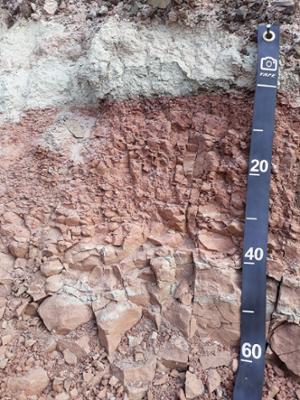

Shedroff and Winget were the only two undergraduate members of the team of approximately 15 scientists. Shedroff shares their experiences from the trip.
A Reflection from the Loperot Site
Every morning my alarm would ring at 5:30 a.m., meaning it was time to throw on hiking clothes, grab my backpack, and head to breakfast. Breakfast consisted of mandazi, fried dough with jam, and warm Kenyan chai tea. We would always get ready before the sun rose, before the day began to heat up. The morning sun was not as intense, and certain outcrops were still shady, thus ideal for fieldwork. Piling into the camp vehicles, all researchers would check if they had their rock hammers, paleo picks, and other equipment, as the Loperot site, a primate fossil site located in the Turkana Basin of Kenya's Rift Valley, was a good drive. The trip involved traversing sandy, open areas where vehicles would frequently become stuck. For passengers, it also meant ducking to avoid thorny acacia branches — a surprisingly effective way to shake off drowsiness.
 Once in the field, different groups would split up based on their research questions. Professor Beck and Marcella were interested in the strategraphic column (the geologic representation of the layering of rock units in an area), so they performed extensive field reconnaissance, exploring various localities and analyzing rock strata. They found all sorts of interesting things as they walked around, such as fossilized oysters, ostracods, and a colorful dike, a sheet of rock that cuts across preexisting rock layers. Other researchers were focused on deciphering the volcanic history and rift basin formation. For my part, I came into the Turkana Project knowing I wanted to study paleosols (fossil soils). Though I had written a paleosol literature review for my East African Rift System class, I knew very little about working with these soils in the field.
Once in the field, different groups would split up based on their research questions. Professor Beck and Marcella were interested in the strategraphic column (the geologic representation of the layering of rock units in an area), so they performed extensive field reconnaissance, exploring various localities and analyzing rock strata. They found all sorts of interesting things as they walked around, such as fossilized oysters, ostracods, and a colorful dike, a sheet of rock that cuts across preexisting rock layers. Other researchers were focused on deciphering the volcanic history and rift basin formation. For my part, I came into the Turkana Project knowing I wanted to study paleosols (fossil soils). Though I had written a paleosol literature review for my East African Rift System class, I knew very little about working with these soils in the field.
I spent my entire field experience at a part of the site from an early Miocene period (roughly 18 million years ago), identifying and describing fossil soils in a trench. I had the opportunity to shadow well-regarded paleopedologist Gary Stinchcomb who focused on describing soils in the field and collecting samples to run in his lab. The goal was to decipher under what conditions each soil formed and to see if it aligned with current paleoclimatic interpretations. Out in the field, I learned a lot about soil descriptions. Meticulously documenting all soil features for just one paleosol could take hours. I was able to observe a range of unique and beautiful paleosols. I learned how to describe soils, a skill I applied independently at the next camp we visited.
 Being out in the field with a large group of scientists and graduate students, I gained a valuable perspective on pursuing research as a career. I learned how important it is to establish connections in the science world. There are times a proposal will get funded or a paper published just because of who the writer is. These are definitely large barriers to overcome.
Being out in the field with a large group of scientists and graduate students, I gained a valuable perspective on pursuing research as a career. I learned how important it is to establish connections in the science world. There are times a proposal will get funded or a paper published just because of who the writer is. These are definitely large barriers to overcome.
At the same time, doing scientific research can be extremely rewarding, depending on the types of questions asked. The Turkana Miocene Project is aimed at reconstructing the paleoenvironment and paleoclimate of East Africa at a key juncture in human evolution. On the large scale, the study of past climates can also teach us about the impacts of global warming. Scientific research allows us to answer interesting, big-picture questions that help us understand how the world works. This experience convinced me to go on to graduate school and study soils, so I can answer my own interesting questions.
In talking about her experiences, Marcella added, “I’ve seen so many amazing things I read about in my sedimentology and structural geology courses really come to life and take shape in ways they don't in the classroom. I have even seen ostracod specimens, the stars of my last research project, in the wild! Being part of this project has shown me how geologists answer questions and work as a team.”
Marcella Winget '24
Major: Geosciences
Hometown: Old Greenwich, Conn.
High School: Greenwich High School
Sara Shedroff '23
Major: Geosciences
Hometown: Miami Beach, Fla.
High School: iPreparatory Academy
Posted August 24, 2022


